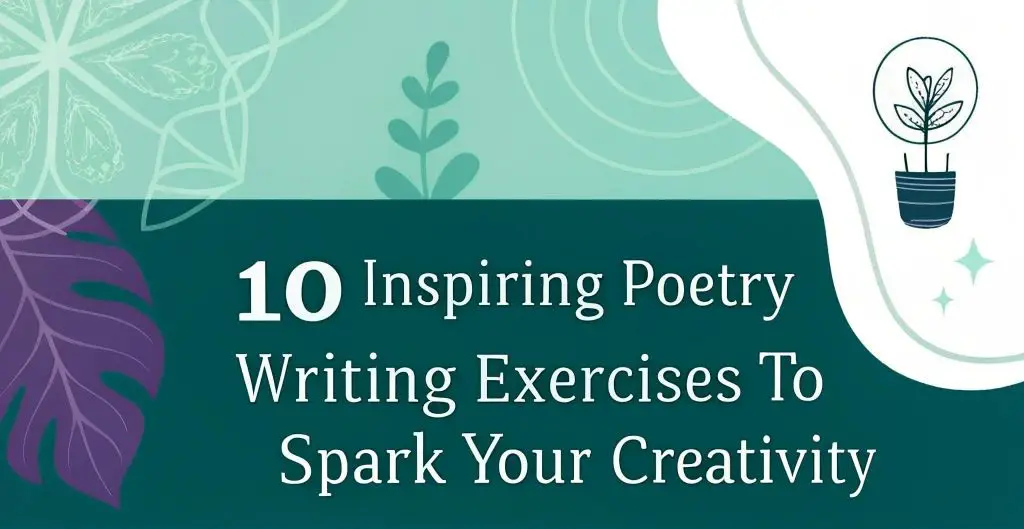Poetry Writing Exercises

Ever feel stuck in a poetry rut? Writer’s block can hit hard, leaving us staring at blank pages. But I’m here to help. I’ve explored poetry exercises that can spark your creativity.
This post will share 10 fun ways to get your words flowing again. Are you ready to break free from that creative slump? Let’s explore and get those poetic juices flowing!
Key Takeaways
- Poetry exercises like writing about your name or talking to ghosts can spark creativity and self-reflection.
- Nature-based prompts, such as planting a seed or finding bits of wildness, help poets focus on growth and change.
- Everyday objects like tin cans or time capsules can inspire unique poem ideas and track a poet’s growth over time.
- Mini autobiographies in 100 words and answer poems push writers to explore personal stories and respond to existing works.
- Unusual writing methods, like composing upside down or in parallel, shake up thinking patterns and lead to fresh perspectives in poetry.
Table of Contents
Imagination Focused Exercises
Let’s spark your imagination with some fun exercises. These will push your mind to new places and help you create fresh, exciting poems.
1. Write about your name
I love using names as a starting point for poetry. Your name holds a world of stories and feelings. It’s the first word you hear as a baby and the one that follows you through life.
I ask my students to write their name vertically on paper. Then, they create a line of poetry for each letter.
This exercise sparks creativity and self-reflection. It’s amazing how much we can say about ourselves through our names.
Names also connect us to our roots and culture. I encourage poets to dig into the meaning and history of their names.
Where did it come from? Who chose it? How does it make you feel? These questions often lead to rich, personal poems.
Some of my students have written beautiful pieces about family traditions, identity, and belonging – all inspired by their names.
2. Dialogue With a Ghost
Moving from writing about your name, let’s explore a more ethereal exercise. Talking with ghosts might sound spooky, but it’s a great way to spark creativity.
This exercise asks you to imagine a chat with a spirit.
Pick someone famous or make up a ghost. Then, write a poem as if you’re having a talk with them.
I find this exercise really fun. It lets me play with different voices and ideas. You can ask the ghost questions or have them share wisdom. Maybe they’ll tell you about their life or give advice.
The key is to let your imagination run wild. Don’t worry about being perfect. Just write and see where the conversation takes you.
It’s a chance to explore history, emotions, and even your own thoughts through a unique lens.
Nature and The Outside Prompts
Nature sparks creativity like nothing else. Step outside and let the world inspire your words.
3. Plant a Seed
I love this exercise. It’s simple yet powerful. I grab a seed – any seed will do. I hold it in my palm and really look at it.
Its shape, color, and texture spark my imagination. I think about its journey from seed to plant.
This helps me create vivid images in my poetry.
As I write, I let my words grow like the plant would. I start small and build up, adding details as I go. This prompt is great for nature poems. It helps me focus on growth and change.
Next, let’s explore how to find inspiration in the wild around us.
4. Find a bit of wild
Nature can spark our creativity in amazing ways. I love to take my students on short walks outside to find bits of wildness.
We look for small details – a dandelion pushing through a crack, moss on a tree, or even a spider’s web.
These tiny glimpses of nature often lead to powerful poems. One student wrote a beautiful piece about resilience after spotting a flower growing from a brick wall.
Getting out of the classroom helps refresh our minds too. The change of scenery and fresh air can break writer’s block.
We bring notebooks to jot down quick observations or lines that pop into our heads.
Back inside, we use these notes as starting points for new poems. This exercise works great for both beginners and experienced poets.
Next, let’s explore how everyday objects can inspire our writing.
Media and Objects as Inspiration
Media and objects can spark fresh ideas for poetry. I love using everyday items as starting points for my poems. They often lead to surprising and creative verses.
5. Write into the tin can
I love this fun exercise that gets your creative juices flowing. Grab an empty tin can and imagine what it might contain.
Maybe it’s filled with colorful memories, secret wishes, or even tiny magical creatures.
Let your mind wander and see where it takes you. Start writing about the contents, describing them in vivid detail.
Don’t hold back – the wilder your ideas, the better! This prompt helps break writer’s block and sparks fresh poetry ideas.
As you write into the tin can, focus on using rich sensory details. What does the inside smell like?
How do the contents feel when you touch them? What sounds do you hear? Paint a picture with your words that brings your imaginary tin can world to life.
This exercise lets you play and explore without limits. It’s a great way to unlock your inner creativity and come up with unique poem concepts.
6. Create a Time Capsule
I love making time capsules for poetry. It’s a fun way to capture my thoughts and feelings right now.
I grab a box and fill it with things that inspire me. Photos, song lyrics, news clippings – anything goes.
Then I write poems about each item. It’s like creating a snapshot of my life in verse.
This exercise helps me see how my writing changes over time. I seal the box and set a date to open it, maybe a year from now.
When that day comes, I’ll read my old poems and write new ones.
It’s a great way to track my growth as a poet. Next, let’s explore some sentimental and reflective prompts to spark your creativity.
Sentimental and Reflective Prompts
Sentimental and reflective prompts tap into our deepest feelings. They help us explore our past and present through poetry.
7. Write a Mini Autobiography
I love using mini autobiographies to spark creativity in my poetry workshops. This exercise gets students to dig deep into their personal stories.
I ask them to write a short life story in just 100 words.
It’s amazing how much they can pack into such a tiny space! They often uncover forgotten memories or see patterns they never noticed before.
The key is to focus on vivid details and strong emotions.
I encourage them to play with different styles too – some write in third person, others use only dialogue.
It’s a great way to find new material for poems and practice concise writing at the same time.
8. Answer Poem
I love to use answer poems as a fun way to spark creativity. Here’s how it works: I pick a poem I like and read it closely.
Then, I write my own poem that responds to or “answers” the original.
This exercise helps me dive deeper into the first poem’s themes and ideas. It also pushes me to think about poetry from a new angle.
Answer poems can take many forms. I might argue with the original poem, agree with it, or expand on its ideas.
Sometimes I’ll mimic the style or structure of the first poem. Other times, I’ll go in a totally different direction.
The key is to let the original work inspire me without limiting my own voice. This prompt often leads to surprising and fresh poetry.
Structure and Form Exercises
Poetry forms can shake up your writing. Try new structures to spark fresh ideas.
9. Write Upside Down & Backwards
I love this exercise! It’s a fun way to shake up your writing. Here’s what you do: Turn your paper upside down and write your poem backwards.
Start from the last word and work your way to the first.
This trick forces your brain to think differently. It breaks old patterns and sparks new ideas.
I’ve tried this myself and it’s amazing how it changes your perspective. You focus on each word more closely.
The flow of ideas becomes fresh and unexpected. Don’t worry about making sense at first.
Just let the words come. You can always edit later. This method often leads to unique images and surprising connections.
10. Compose a poem in parallel
I love to play with form in poetry. One fun exercise is to compose a poem in parallel. This means writing two poems side by side that relate to each other.
You can use the same theme, but tell different stories.
Or you can use the same words, but in a different order. The key is to make the poems work together and apart.
It’s a great way to explore contrast and connection in your writing.
This exercise pushes you to think creatively about structure and meaning. You might find new ideas emerging as you craft your parallel poems. Don’t worry about making them perfect.
Just let your imagination flow and see what happens. You could even try reading the poems aloud together for a unique effect. It’s all about exploring and having fun with your poetry.
Concluding Thought on Poetry Writing Exercises
These ten exercises offer a fresh take on poetry writing. They push us to see the world in new ways. We can tap into our inner voice and find beauty in the everyday.
With practice, we’ll grow more confident in our craft. So grab a pen, pick an exercise, and let your creativity flow!
FAQs About Poetry Writing Exercises
1. What are some easy poetry writing exercises for beginners?
Easy exercises include free verse writing, using a timer for quick poems, and jotting down words that come to mind. Don’t worry about grammar or spelling – just put pen to paper and let your thoughts flow. Try writing about what you see out the window or describe an object using the five senses.
2. How can writing prompts help spark creativity in poetry?
Writing prompts serve as jumping-off points for your imagination. They can be phrases, images, or even random words. These prompts push you to think differently and explore new ideas. For example, try writing a poem using only words from your favorite book or TV show.
3. Are there exercises to help with specific poetic forms?
Yes! To practice sonnets, try writing 14 lines in iambic pentameter. For a sestina, choose six words and use them as end words in a specific pattern. Don’t be afraid to experiment with different forms – it’s all part of the creative process.
4. How can I improve my use of metaphors in poetry?
To boost your metaphor skills, make a list of mundane objects and pair them with emotions or abstract concepts. For instance, compare love to a scrabble tile or fear to a marker. Keep a notebook handy to jot down interesting comparisons you notice throughout your day.
5. What’s a good exercise for overcoming writer’s block?
One effective method is the “stream of consciousness” technique. Set a timer for 10 minutes and write non-stop without lifting your pen or fingers from the keyboard. Don’t worry about punctuation or making sense – the important thing is to keep writing. This helps bypass your inner critic and can lead to surprising discoveries.
6. How can reading poetry help with writing exercises?
Reading poetry exposes you to different styles, forms, and use of language. Try this exercise: choose a poem you admire and write your own piece using its structure or rhythm as a guide. This helps you understand poetic techniques and can inspire new ways of expressing yourself in your next poem.



